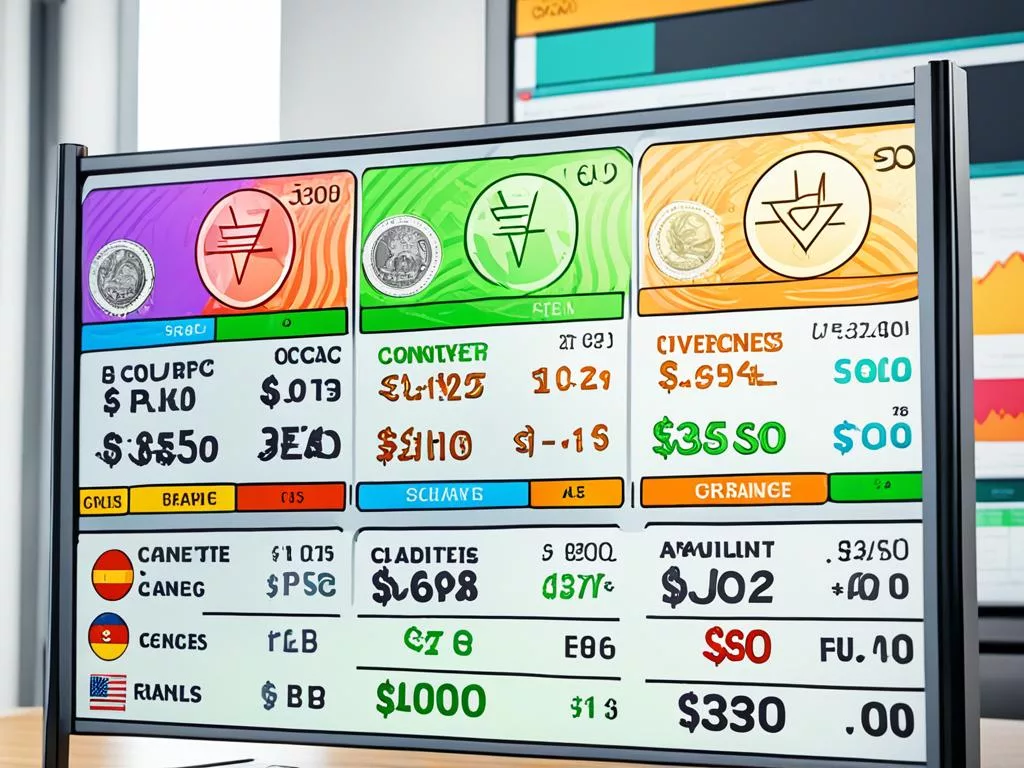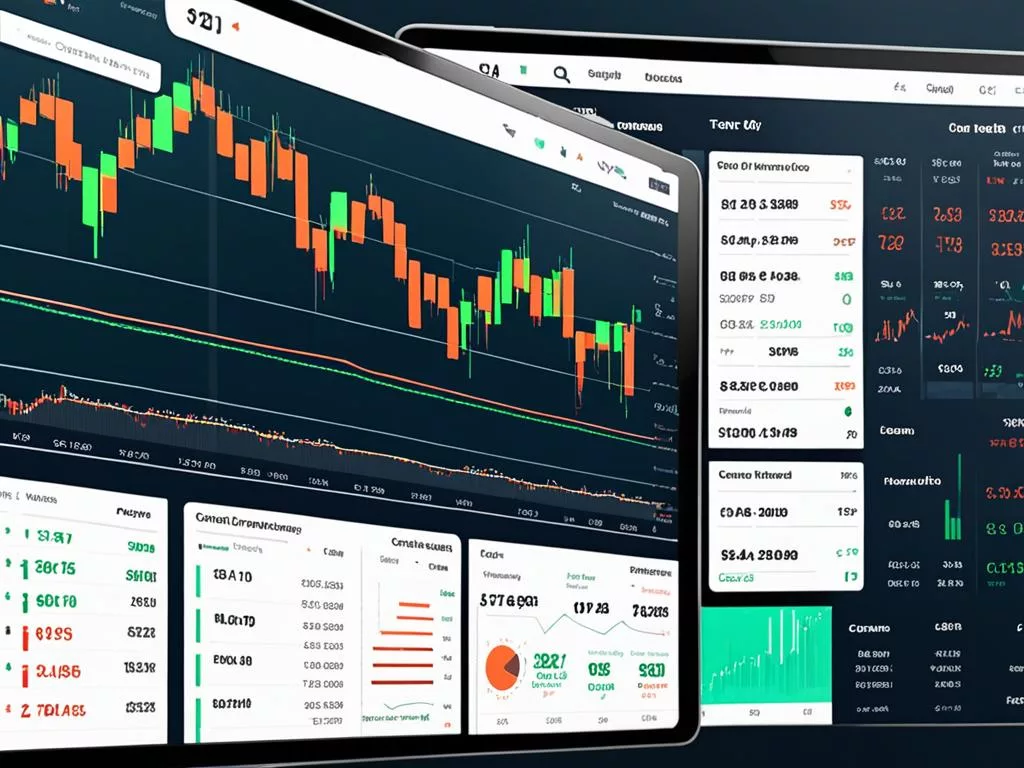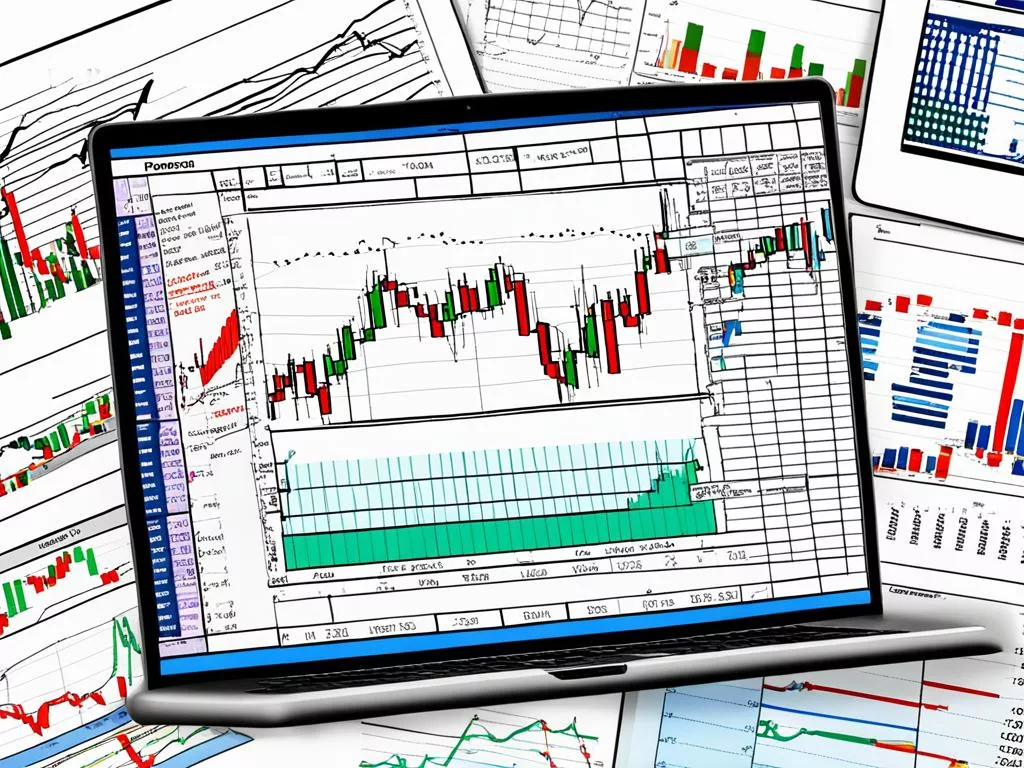As I delve into the intricacies of global finance, the harmonious yet unpredictable dance between the U.S. dollar and the euro in the forex market often reminds me of a delicate balancing act1. Just like so many around the world, my pulse quickens when the EUR/USD—forex’s most popular currency pair—fluctuates, driven by the relentless tides of economic factors, commercial demands, and the sheer force of financial trading1. There’s an art to navigating this dynamic realm, and it begins with having the right live currency exchange tools at my fingertips, offering a glimpse into the present and an insight into the future.
My trust in these digital oracles grows with each successful transaction secured by using trustworthy foreign exchange rate websites, like XE.com and Yahoo Finance, knowing that even the smallest errors in exchange rate calculations can lead to significant repercussions1. Whether for a seasoned trader or a curious traveler, deciphering the enigma of exchange rates hinges upon the power of currency converter apps, which curate data as influenced by the invisible hands of free-market forces, central bank interventions, and government policies1. This collective wisdom shapes not only my financial strategy but also the fortunes of nations, as inflation and forward rates unfurl upon the canvas of the global economy1.
Today, I stand equipped, empowered by the digital age where accurate currency conversions are seamlessly woven into my daily life. The tools I’ll introduce in this article are not merely instruments for financial mastery; they are my companions in a world where understanding the ebb and flow of currencies is as crucial as the air we breathe.
The 5 Best Tools to Read and Calculate Exchange Rates
As a professional in the financial world, I rely heavily on effective tools for monitoring and calculating exchange rates. In my experience, the most powerful asset for this purpose is a real-time currency converter, which provides instantaneous updates and ensures brisk reactions to the forex market’s volatility2. Tools such as MetaTrader 4 and MetaTrader 5 stand out among the 5 best tools to read and calculate exchange rates, revered for their comprehensive real-time forex market analysis capabilities3. When it comes to the EUR/USD pair, these platforms are indispensable due to its status as the most popular currency pair and reserve currency at many global central banks2.
- Real-time Currency Converters: These are crucial for businesses to respond quickly to currency pair fluctuations stemming from economic factors like supply and demand and central bank or government influences23.
- Advanced Trading Platforms: MetaTrader 4 and 5 shine as exemplary tools, offering detailed analysis and the ability to stay on top of the forex market, which operates 24 hours a day during the week3.
- Charting Software: Enhanced with economic calendars, such software becomes essential in forecasting market movements based on a myriad of economic indicators2.
- Pip Calculators: Small currency fluctuations can significantly impact large transactions, making pip calculators vital in assessing potential financial outcomes2.
- Financial News Wires: Keeping abreast with the latest in economic news can affect exchange rate predictions and, therefore, financial strategies2.
Airport currency exchanges are a clear example of the disparity in the market; they profit by imposing a broader spread between currencies2. To counter this, utilizing platforms that provide precise exchange rates and narrower spreads is critical for anyone needing to convert large sums efficiently.
In recent years, finer pricing strategies, such as those introduced by Barclays Capital with up to six decimal places, have become the norm. This shift towards more detailed quoting helps in accurately pricing currencies and managing risks associated with forex trading3. Moreover, understanding forward exchange rates—set based on the current spot rate plus carrying costs—is crucial for hedging against future currency fluctuations, another task made manageable by sophisticated financial tools2.
Here’s a look at the tools that have changed how we deal with currencies:
| Tool | Real-time Data | Analysis Features | User-Friendly | Additional Notes |
|---|---|---|---|---|
| MetaTrader 4/5 | Yes | Comprehensive real-time market analysis | High | Widely accepted among professional traders |
| Charting Software | Yes | Incorporates economic calendars and pip calculators | Varies | Essential for technical analysis and prediction |
| Pip Calculators | N/A | Calculates the value change in currency pairs | High | Direct impact on risk management |
| Economic Calendars | N/A | Tracks financial events affecting forex | High | Indispensable for strategic planning |
| Financial News Wires | Yes | Provides latest economic news and analysis | High | Quick updates on factors affecting markets |
Exchange rates are not just numbers; they narrate a story of economies in interplay. The sheer volume of trading, as noted by the BIS at US$5.3 trillion per day in the interbank market3, and the continuous trading available from Sunday evening to Friday night illustrate the dynamic nature of this market3. It’s a realm where major exchange rates, once traditionally quoted to four decimal places, now shift with up to six decimal places for precise measurement3.
In summary, the profound influence of free-market forces, central banks, government policies, and now more than ever, technology, define the forex landscape2. Stellar tools, including real-time currency converters, have not only simplified the daunting process of dealing with exchange rates but also empowered me to navigate the market with clarity and confidence.
Understanding the Role of Real-Time Currency Converters in Exchange Rate Analysis
As I delve into exchange rate analysis, the significance of real-time currency converters becomes increasingly evident, providing not just accurate currency conversions but also a window into the ever-evolving forex market4. By granting me instant access to the latest exchange rates, these tools are indispensable for making informed decisions, whether I’m calculating costs for international travel or assessing trade positions4.
Exchange rate calculators go beyond basic conversions; they are crucial for recognizing and adapting to market trends, especially in a market where the majority of trading is conducted by institutional traders and the U.S. dollar reigns supreme4. With currencies like the euro following close behind, and the seven major currency pairs dominating approximately 75% of all trades4, having an accurate, up-to-date analytical tool is vital for my trade strategies.

The adoption of these converters equips me with the deftness to rapidly respond to market shifts, a capability that’s all the more essential when considering that retail trading encompasses just a sliver of the global forex market, at 5.5%, and a significant portion of retail FX traders, around 71%, end up in losses4. Furthermore, exchange rates aren’t just numbers on a screen; they influence the cost of traveling abroad and export prices, making precise currency conversion a matter of financial prudence for businesses and travelers4.
On the global stage, the Australian dollar serves as the sixth most traded currency, highlighting the interconnectedness of world economies and the importance of monitoring a variety of exchange rates5. Countries like Australia, which have upheld a floating exchange rate regime since 1983, underscore how market forces of supply and demand ascertain currency values, strengthening my analysis with layers of market-driven data5.
An essential aspect of exchange rate calculators is their ability to grasp broader economic trends through mechanisms like the trade-weighted index (TWI) and cross rates, offering a comprehensive view beyond bilateral exchange rates typically quoted against the dominant US dollar5. With tools that consider the broader tableau of currencies, including those tied to pegged exchange rate regimes, my comprehensive market analysis can accommodate varying international fiscal policies and currency fluctuations5.
To underpin my strategic decisions and currency transactions, I also rely on forecasting exchange rates, a vital task in handling international business and managing asset flows denominated in foreign currencies6. Integrating forecasting approaches, whether fundamental, informed by economic indicators like GNP and inflation rates, or technical, hinged on historical patterns, allows me to create a more dynamic and informed narrative when it comes to currency exchange6.
In my pursuit for precision in forecasts, I consider Mean Square Error (MSE) values to assess the forecasting models’ accuracy, and discriminate between in-sample forecasts, which pertain to existing data, and out-of-sample forecasts that venture into predictive territory6. The careful partitioning of data into estimation, validation, and out-of-sample periods is crucial for refining these models, providing rigor to my forecasting activities and ultimately optimizing my exchange rate analysis6.
Maximizing Foreign Exchange Analysis with Forex Trading Platforms
As someone deeply invested in the world of currency trading, I’m always on the lookout for the best tools to enhance my trading strategies. It’s no surprise that Forex trading platforms like MetaTrader 4 and MetaTrader 5 have revolutionized my approach to the markets. Replete with powerful analytical capabilities, they provide real-time market analysis, which is vital considering recent findings that up to 90% of professionals rely on some form of technical analysis7. The ever-evolving landscape of Forex trading has been significantly influenced by sophisticated algorithmic trading, which now accounts for a substantial portion of global FX spot trading8.

To put it plainly, the advancements in algorithm trading have redefined the capabilities of these platforms. With MetaTrader 4 and MetaTrader 5, I can harness the power of various algorithms, such as Random Forest and SVM, which have been proven to forecast currency exchange rates with impressive accuracy and robustness7. The inclusion of these algorithms complements my analytical efforts, empowering me with deeper insights into the markets.
- EAs have advanced from simple mechanical forms to adaptive types8.
- Up to 20% of FX trading is through execution algorithms8.
- 90% of traders utilize technical analysis for predictions7.
The practicality of Forex trading platforms doesn’t end with their analytical prowess. Their mobile app integration ensures that I can take advantage of every trading opportunity, no matter where I am. This is crucial as the FX market now witnesses a greater electronic and automated presence, increasing the use of execution algorithms by various financial entities8. Moreover, the platforms’ robust functionality allows me to aggregate order book data across liquidity pools efficiently, optimizing my trade executions in a highly fragmented market8.
| Platform Feature | MetaTrader 4 | MetaTrader 5 |
|---|---|---|
| Algorithmic Trading | Supported | Advanced Support |
| Mobile App Integration | Yes | Yes |
| Market Execution | Instant Execution | Market Execution |
| Technical Analysis Tools | Comprehensive | More Advanced |
In conclusion, the fusion of MetaTrader 4 and MetaTrader 5 into my trading regimen aligns perfectly with the shifting dynamics of Forex markets. The platforms’ innovative features, along with my reliance on technical analysis and the latest in algorithmic trading, significantly improve my likelihood of success. They not only support the strenuous demands of currency trading but also open new horizons for research and strategy optimization, making what was once impossible research, now a rewarding reality7.
Charting Software and Technical Indicators: Unveiling Market Trends

As I delve into the world of forex trading, I often rely on charting software to provide me with up-to-date visual cues on forex market trends. It’s essential to analyze the market with tools that can simplify and interpret complex data. For instance, TradingView has become a go-to for over 50 million users seeking comprehensive chart analysis capabilities9. I integrate candlestick charts widely regarded as a trader’s staple due to their detailed representation of price movements9.
Efficiency in trading is also about workspace optimization. Utilizing multiple monitors allows dedicated screens for different functions—one for precise order entry and others for extensive charting and technical analysis software applications9. I find it beneficial to maintain a consistent chart layout and keep backgrounds to neutral colors, so key data points, like red and green price bars, are immediately discernible9.
- Use of volume indicators below price charts for in-depth market analysis9
- Line charts for evaluating long-term trend patterns9
- Bar charts, which are indispensable for short to medium-term trading decisions9
- Employment of trendlines to assess the strength of market trends9
While charting software offers a visual framework for market trends, the role of technical analysis software cannot be overstated when it comes to forecast precision. These tools often incorporate fundamental and technical indicators which, when used in tandem, enhance stock selection and strategy formulation10. For instance, integrating an EPS metric or P/E ratio as part of a broader analysis helps pinpoint potentially undervalued stocks, suitable for inclusion in a value-driven portfolio10.
| Technical Indicator | Purpose | Preferred Usage |
|---|---|---|
| Moving Averages | Trend identification | Momentum traders seeking stocks above their 20-day moving average10 |
| Stochastic Oscillator | Momentum and reversal detection | Analyzing entry strategies for trading breakouts or pullbacks10 |
| Price Patterns & Volume | Validation of trend strength | Selecting and analyzing stocks for potential moves10 |
Finally, it’s essential to underscore the importance of a careful selection of chart elements. A cluttered interface can obscure critical market trends, whereas a streamlined display will ensure focus remains on pertinent data. By using these methodologies, you can convert complex market activities into actionable insights, thereby wisely navigating through the variegated terrain of the forex markets9.
Unlocking Market Potential with Economic Calendars
As a seasoned market analyst, I’m always on the lookout for tools that can give investors a competitive edge, and economic calendars stand out as a key resource for those keen on market analysis. These calendars are diligently designed to foreground critical financial events, allowing one to anticipate and strategize around the economic indicators that drive market sentiment.
For instance, the impressive 3.2% growth in the U.S. economy during the fourth quarter of 2023 is the kind of pivotal data that economic calendars would highlight well in advance. Investors who kept their eyes on these resources would have foreseen the boost in confidence that potentially led to equity markets reaching all-time highs in the first quarter of 2024
Labor market statistics are also pillars of financial events that significantly affect market forecasts. The consistency of job additions, averaging 250,000 per month throughout 2023, and the full recovery of the labor force participation rate for the working-age population display the resilience of the economy and often preface upward trends in consumer spending and investment, all information that economic calendars meticulously catalog for their users
Inflation rates are yet another cornerstone of economic calendars, with the CPI inflation maintaining a rate of around 3.2% since October 2023, thereby providing a bellwether for interest rates and monetary policy shifts. The Federal Reserve’s projection of rate cuts to 5.25%-5.50% in 2024 speaks volumes to those reading between the lines of financial events, suggesting a pivot in the policy outlook that could affect various asset classes
To effectively harness this influx of data, I always integrate economic calendars into my daily market analysis routine. This practice helps me link disparate pieces of economic news – like the trending lower core goods prices due to easing supply chain distortions and flat earnings growth despite robust economic activity – into a cohesive narrative that informs sound investment decisions
Here’s a glance at the power of economic calendars in capturing essential data:
| Indicator | Details | Impact |
|---|---|---|
| U.S. GDP Growth Q4 2023 | 3.2% | High |
| U.S. Monthly Job Additions 2023 | 250,000 | High |
| Federal Reserve Rate Cuts 2024 | Three Reductions | Medium |
| CPI Inflation Since Oct. 2023 | 3.2% | Medium |
| Labor Force Participation Rate Recovery | Fully Recovered | High |

Overall, tapping into the timely and comprehensive data provided by economic calendars empowers traders to proficiently navigate through the tumultuous seas of financial markets. Recognizing the profound impacts of employment figures, inflation rates, GDP numbers, and central bank decisions is just a part of the equation; predicting and preparing for the ripples they send across markets is where economic calendars prove their true value in the realm of financial events.
Exchange Rate Calculators: Simplifying Financial Decisions and Risk Management
In my role as a forex trader, I’ve found that understanding and applying hedging strategies, such as cash flow hedging and balance sheet hedging, is crucial in risk management, particularly when navigating the complexity of international trade11. Balance sheet hedging can often be the starting point for many due to its relative simplicity and the availability of data11. Simultaneously, I’ve always emphasized the importance of tools like exchange rate calculators which provide insights into potential risks and help with accurate trade risk management. The use of such calculators, combined with effective strategies to mitigate risks linked with FX rate fluctuations and their impact on financials, can offer a substantial advantage1112.
As I delve deeper into international markets, I’ve appreciated the role of pip calculators in illuminating precise trade impacts and informing my entry and exit strategies. With global companies becoming increasingly prevalent, cash flow hedging becomes indispensable for protecting profit margins against currency risk11. Additionally, by tapping into the array of financial instruments and consulting with professionals in treasury management, I’ve enhanced my understanding of how currency swaps and hedged portfolios can shield against adverse exchange rate movements or provide a cushion for equity in foreign subsidiaries1113.
My portfolio management approach has been transformed by integrating financial instruments and automation tools like Nordea’s AutoFX solution, which significantly reduces manual tasks and operational risks12. By leveraging such tools, not only do I streamline decision-making, but I also gain a clear picture of how currency fluctuation can impact both individual transactions and long-term financial strategies. This comprehensive approach to managing FX risk ensures that my financial objectives remain within reach, even amidst the turbulence of the forex market12.
Source Links
- https://www.thebalancemoney.com/how-to-read-and-calculate-exchange-rates-1978919
- https://www.thebalance.com/how-to-read-and-calculate-exchange-rates-1978919
- https://en.wikipedia.org/wiki/Exchange_rate
- https://www.forbes.com/advisor/investing/what-is-forex-trading/
- https://www.rba.gov.au/education/resources/explainers/exchange-rates-and-their-measurement.html
- https://www.bauer.uh.edu/rsusmel/7386/ln5.pdf
- https://www.hindawi.com/journals/acisc/2019/8342461/
- https://www.bis.org/publ/mktc13.pdf
- https://www.investopedia.com/articles/trading/10/high-performance-charts.asp
- https://www.schwab.com/learn/story/how-to-pick-stocks-using-fundamental-and-technical-analysis
- https://www.usbank.com/financialiq/improve-your-operations/minimize-risk/risk-management-strategies-foreign-exchange-hedging.html
- https://www.nordea.com/en/news/5-steps-to-manage-your-currency-risk
- https://www.investopedia.com/articles/forex/11/hedging-with-currency-swaps.asp

